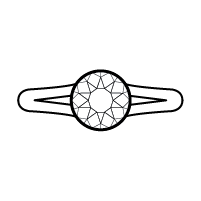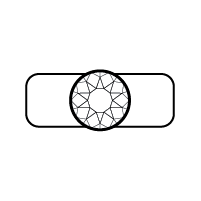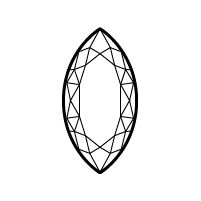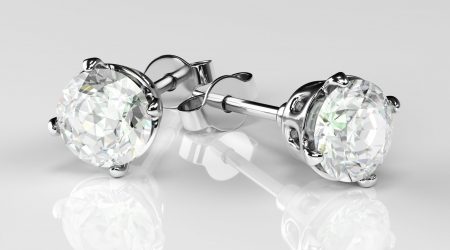There can be many decisions to be made when shopping for jewelry, and one of the most important decisions shoppers will make is which metal they’ll want for their piece. Will you choose gold? Silver? Or the most precious of all precious metals, platinum? The metal you choose could greatly change the overall character and price point of your final product. Our Chrysella experts have identified some of the benefits, as well as downsides, for choosing platinum for your next piece of jewelry.
Durability
The sheer durability of platinum is one of the most appealing characteristics of this metal. Platinum’s exceptional strength and high density has historically made platinum one of the most popular choices for shoppers wanting a high quality and lasting piece of jewelry. With a density of 21.45 grams per cubic centimeter, platinum is notably more dense than gold’s 19.3 grams per cubic centimeter. The strength of platinum becomes beneficial in everyday use given that it’s more likely to move or bend as opposed to simply breaking like most other metals.
For example, if you were to turn a corner and accidentally slam your white gold solitaire ring against a sharp edge, it’s highly likely a prong will break off of the ring completely. But if that same ring happened to be entirely made of platinum, all you’d have to worry about is a bent prong that your local jeweler can repair within a day.
Rarity
Many people are not aware of just how rare platinum truly is. Roughly 190 metric tons of platinum is mined each year in comparison to approximately 3,300 metric tons of gold. And much like diamonds, the majority of platinum mined ends up used for industrial purposes.
Below is a mind-blowing visualization of the rarity of platinum, courtesy of Cornell’s Jewelers:
(Source: Cornell’s Jewelers)
No Metal Memory
Working with metals can be a very meticulous and delicate process. Different metals have inherently different tendencies and can behave uniquely from one another. For example, gold is sometimes described as being “springy.” Meaning when bending gold over a stone after casting it will naturally want to move back to its previous position overtime. Golds “springy” tendency can create frequent visits to your jeweler for service. Conversely has no metal memory at all. Therefore, once it’s put into a position, it will assume that position until forcefully changed. This means platinum has superior holding power over other precious metals, making it a great choice for those who want to avoid frequent visits to their jeweler.
Naturally White Metal
White metals are an extremely popular choice for engagement rings and wedding bands. However, did you know that white gold isn’t naturally white? All white gold actually starts as yellow gold. Goldsmiths add naturally white metals, such as aluminum and nickel, to create somewhat of a greyish, yellowish mix of molten metal. They use this mixture to create their desired piece of jewelry. Following this process, jewelers then plate the piece of jewelry using electro-rhodium plating to create the high luster bright white finish you see in white gold jewelry. greyish yellowish mixture to a beautiful chrome white, highly polished product. With all of this being said, platinum is one of the few naturally white metals in the world that does not require any plating as described above.
From the moment it is mined, platinum will maintain a natural white look through its entire lifespan, platinum will have a natural white metal look that can bring your diamond to life in a way few metals can. This means the metal in your piece will have a much higher level of purity and you will save money throughout the lifespan of the piece as it does not require yearly rhodium plating
Hypoallergenic

Like we previously mentioned in this article, precious metals are often alloyed with other metals for coloring, increasing durability, or to make a piece less expensive. Nickel is one of the more commonly added materials in the alloying process, however it is also a well known allergen. Some are allergic to alloy metals and experience discomfort and itchiness on their skin if they are to wear a piece of jewelry with traces of nickel. This is something you don’t need to worry about with platinum. Platinum jewelry is commonly comprised 90-95% platinum and 5-10% an alloy metal, making it one of the few hypoallergenic precious metal choices for jewelry lovers. Couples enjoy the benefit of never having to experience discomfort or irritation by wearing platinum.
While there are many more advantages of platinum that we are not covering in this article, it’s time we highlight a few of the short sides of the precious metal.
Wear and Tear

(Source: Withclarity.com)
While platinum is the strongest metal one could find, it experiences a unique form of cosmetic wear and tear. Platinum tends to develop a patina more rapidly than gold. This requires it’s wearer to polish the platinum with their jeweler more often than they would with gold. While some enjoy a unique patina on their platinum, others prefer that original shine.
Price
With immense rarity and purity, comes a price to pay. Platinum is simply one of the most expensive metals you can choose for your jewelry, but like you’ve seen thus far there are plenty of benefits you’ll be receiving as well. Platinum purchasers can expect to pay 25% more for platinum than other precious metals.
The word platinum expresses an elite quality in our culture today. It communicates the best of the best, and that is more than true when the precious metal is used in jewelry. Platinum is undeniably an excellent choice for any piece of jewelry. While you will be met with a slightly higher upfront cost, the many benefits surely outshine the added cost. Choose platinum for your next piece of jewelry and enjoy it with peace of mind. Shop our collection of decadent platinum pieces by visiting Chrysella.com










































